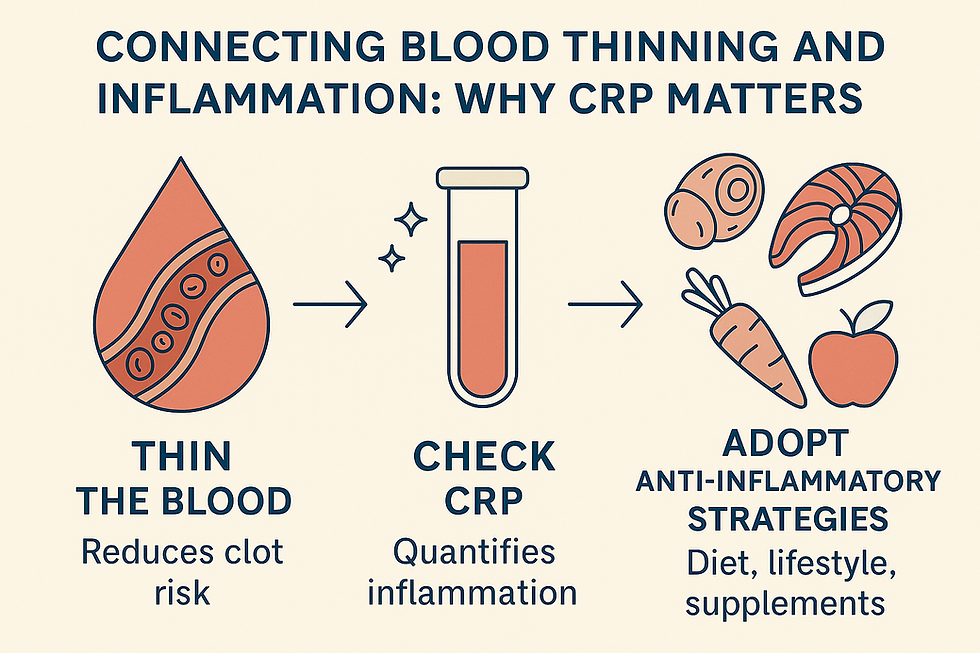Connecting Blood Thinning and Inflammation: Why CRP Matters
- Jul 31
- 4 min read
Natural blood thinners like CRV Protector play a vital role in reducing clot formation by inhibiting platelet aggregation and improving blood flow. Yet, thinning the blood addresses only one piece of cardiovascular health. Underlying inflammation drives atherosclerosis—the buildup of plaque in arterial walls—making vessels stiffer, narrower, and more prone to clot-forming ruptures. To manage cardiovascular risk holistically, monitoring inflammation through C-reactive protein (CRP) levels is essential.

What Is CRP and How Is It Tested?

C-reactive protein is produced by the liver in response to inflammation anywhere in the body. The high-sensitivity CRP (hs-CRP) test measures even low-grade inflammation, offering insight into cardiovascular risk.
Testing Method: A simple blood draw yields a sample that is analyzed in a laboratory. In-clinic hs-CRP assays can detect levels as low as 0.3 mg/L; at-home kits also exist, using a fingertip prick and mailed samples for lab processing (Mayo-Clinic)
Preparation & Risks: Minimal preparation is needed, though strenuous exercise or certain medications can transiently raise CRP. Risks are limited to mild soreness or bruising at the puncture site (Mayo-Clinic)
Interpreting CRP Levels
CRP Level (mg/L) | Risk Category |
< 1.0 | Low |
1.0 – 3.0 | Average |
> 3.0 | High |
> 10.0 | Possible acute inflammation; repeat testing after two weeks recommended |
Persistently elevated hs-CRP—even in the 3.0–10.0 mg/L range—signals chronic low-grade inflammation and greater cardiovascular risk. Values above 10 mg/L often indicate an acute infection or injury and warrant further evaluation (Testing.com , Quest-Diagnostics).
Symptoms and Risks Associated with Elevated CRP
Chronic inflammation can be “silent,” but over time contributes to:
Atherosclerosis & Plaque Rupture: Raising the likelihood of heart attack and stroke.
Insulin Resistance & Type 2 Diabetes: Inflammatory cytokines interfere with insulin signaling.
Joint Pain & Degenerative Arthritis: Cytokine-driven cartilage breakdown.
Fatigue & Malaise: Systemic effects of pro-inflammatory mediators.
Because CRP is nonspecific, results should be interpreted alongside clinical findings and other lab tests (National Library of Medicine).
Natural Strategies to Lower CRP
1. Turmeric (Curcumin)
A robust meta-analysis of randomized controlled trials demonstrated that curcumin supplementation (≤1,000 mg/day) significantly lowers hs-CRP levels, with stronger effects seen in interventions lasting up to 10 weeks PubMed.
2. Omega-3 Fatty Acids (EPA & DHA)
An umbrella meta-analysis covering 32 studies found that marine-derived n-3 PUFAs significantly reduce serum CRP (effect size –0.40; 95 % CI: –0.56, –0.24) as well as other inflammatory markers like TNF-α and IL-6 PubMed.
3. Berries & Polyphenol-Rich Foods
Anthocyanin-rich berries (e.g., blueberries, raspberries) have been shown in intervention trials to reduce CRP by inhibiting pro-inflammatory pathways, though individual study sizes vary.
4. Mediterranean-Style Diet
Emphasizing fruits, vegetables, whole grains, legumes, olive oil, and fish, the Mediterranean diet has been associated with CRP reductions of about 1 mg/L in older adults over several months (John Hopkins Medicine).
5. Fiber-Rich Foods
Oats, legumes, flaxseed, and other high-fiber foods support a healthy gut microbiome, which in turn lowers systemic inflammation. Observational studies link higher fiber intake with lower CRP, and controlled trials are ongoing.
Lifestyle Factors That Matter
Regular Exercise: Moderate aerobic activity three to five times per week can lower CRP by improving endothelial function and reducing visceral fat.
Weight Management: Losing 5–10 % of body weight often leads to measurable CRP reductions, as adipose tissue produces pro-inflammatory cytokines.
Stress Reduction: Chronic psychological stress elevates cortisol, which can upregulate inflammatory mediators—mindfulness, yoga, and adequate sleep help modulate this effect.
Targeted Support: Triset’s Natural Inflammation Formula

Beyond individual foods and lifestyle changes, some people benefit from comprehensive, science-backed formulas. Triset combines a synergistic blend of natural ingredients to support CRP reduction and overall inflammatory balance:
Apple Cider Vinegar: Promotes liver detoxification and has demonstrated anti-inflammatory properties.
Trehalose: Protects cells against oxidative stress and inflammation.
D-Mannose: Supports kidney health and may reduce systemic inflammation.
Low-Calorie Natural Sweeteners (stevia, monk fruit, xylitol, sorbitol, erythritol): Provide sweetness without glycemic spikes or inflammatory effects.
Carrot Fiber: Rich in antioxidants, aiding digestion and liver health.
Lactobacillus reuteri: A probiotic strain shown to modulate gut-driven inflammation.
By targeting multiple pathways—oxidative stress, gut health, and metabolism—Triset complements dietary and lifestyle measures to help manage chronic inflammation without pharmaceutical side effects.
Monitoring Progress with Your Healthcare Provider
Testing Frequency: Recheck hs-CRP every 3–6 months to assess the impact of diet, lifestyle, and supplements.
Holistic Evaluation: Interpret CRP alongside cholesterol, blood pressure, glucose, and patient symptoms.
Medication Interactions: Always consult a healthcare professional before combining supplements (e.g., omega-3s, Triset) with prescription medications like anticoagulants or statins.
Putting It All Together
Thin the Blood: Continue with natural thinners like CRV Protector to reduce clot risk.
Check CRP: Use hs-CRP testing to quantify inflammation and stratify cardiovascular risk.
Adopt Anti-Inflammatory Strategies: Integrate turmeric, omega-3s, berries, fiber, and a Mediterranean-style diet.
Consider Targeted Formulas: Support your efforts with comprehensive blends such as Triset.
Track & Adjust: Reassess with your healthcare provider to refine your personalized wellness plan.
Addressing both blood viscosity and underlying inflammation empowers you to take proactive, natural steps toward sustained cardiovascular health. By combining CRV Protector with informed lifestyle choices, dietary strategies, and targeted supplements like Triset, you create a robust defense against the twin threats of clot formation and chronic inflammation.



Comments